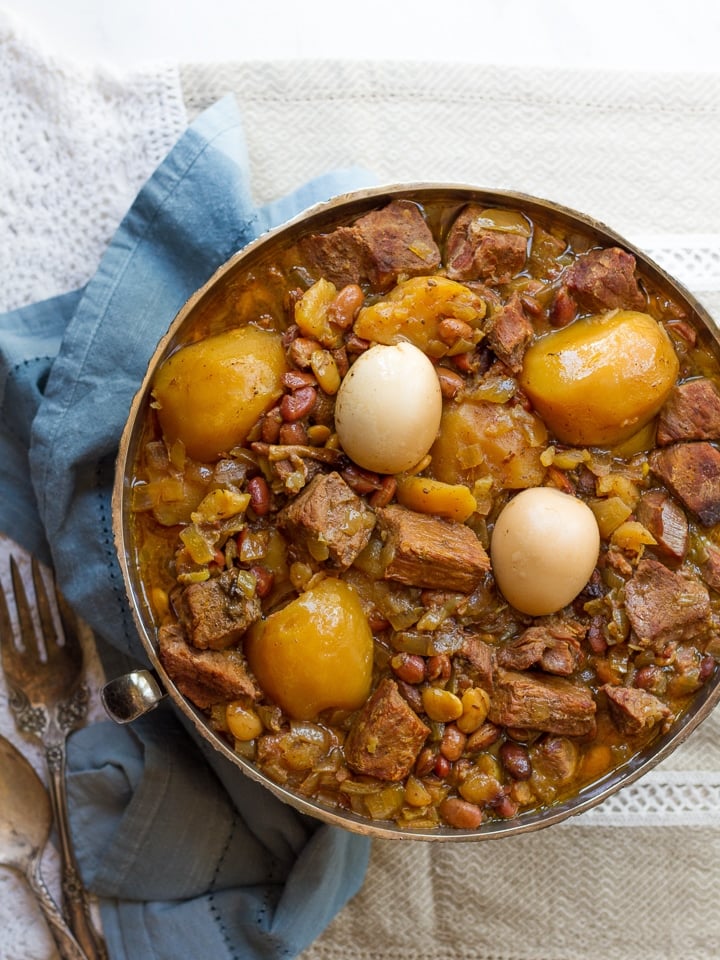
Schalet is the food of heaven,
Which the Lord Himself taught Moses
How to cook, when on that visit
To the summit of Mount Sinai…
Schalet is the pure ambrosia
That the food of heaven composes—
Is the bread of Paradise;
And compared with food so glorious…
From the poem Princess Sabbath by Heinrich Heine,
translated by Edgar Alfred Bowring
Since Biblical times the Jewish people have scattered and settled all over the globe, adapting their foods to suit the regions where they’ve settled. Over the centuries countless regional ethnic dishes have been made kosher to fit the Jewish religious standards for pure eating. This means that “Jewish food” is really world cuisine; there are very few dishes that are uniquely Jewish. Bagels? A Polish baked bread originally created for Lent and later embraced by the Jews. Gefilte fish? A German dish adopted by Yiddish cooks. But cholent– well, cholent is one of the few foods that is totally and completely Jewish.
In Joan Nathan’s fabulous book Jewish Cooking in America, she writes about this distinction:
“Throughout their wandering history, Jews have adapted their life-styles to the local culture. Food is no exception. Following the same dietary laws, Jews, relying on local ingredients, developed regional flavors. Because they have lived in so many places, there is no ‘Jewish food’ other than matzah; haroset (the Passover spread); or cholent or chamim (the Sabbath stews that surface in different forms in every land where Jews have lived).”
Cholent is uniquely Jewish. It was created because Jewish law does not permit cooking on Shabbat. To adhere to this prohibition, Jewish cooks began to create meat and bean stews in heavy pots that would slowly simmer inside a low-heat oven overnight. They would prepare the stew on Friday before sundown, cook it partially, and place it into the oven to continue cooking throughout the night. That way, there would be no need to kindle a fire or light a stove during the hours of Shabbat; they would simple remove the stew from the oven at mealtime and it would be fully cooked and ready to serve.

Cholent is partially cooked before the Shabbat candle lighting at sundown on Friday evening, then placed in the oven to slowly finish cooking overnight.
According the The New Jewish Holiday Cookbook by Gloria Kaufer Greene, the word cholent may have come into usage in medieval Europe:
“The medieval word cholent (with ‘ch’ pronounced as in ‘chair’) may have come from the French chaud-lent, meaning ‘warm slowly,’ or, less likely, from the Yiddish shul ende which describes when the cholent is eaten — at ‘synagogue end.'”
My friend, food historian Gil Marks, refutes this notion of shul ende being the root of the word, because the word cholent was used in France before Yiddish developed as a language in the mid 1200’s. In his Encyclopedia of Jewish Food, he contends that the word most likely evolved from the French chaud (hot) or from the Spanish escallento (warm), since the dish probably made its way to France from Spain. Still others believe that the word cholent is derived from the Hebrew she’lan, meaning “that rested” and referring to the pot resting in the oven overnight.
While nobody knows the exact source of the word cholent, it is without a doubt one of the most beloved dishes in Jewish cuisine.
A Cholent By Any Other Name
Shabbat stews are cooked all over the world in different ways and under many different names. Here are a few of the many varieties of cholent:
Schalet – The Yiddish word for cholent, referred to in the German poem at the beginning of this blog. Schalet refers to an Eastern European-style cholent with meat, beans, barley, and sometimes kishke. Spicing is minimal; often only salt and pepper are used.
Hamin/Hamim/Chamim/Chamin – From the Hebrew word “hot.” The Sephardic version of cholent is known as hamin. Popular throughout Israel, hamin is often made with chicken rather than meat and usually contains eggs. It is also spiced more exotically than Eastern European cholent.
Dafina & Skhina – In Spain, the Maghreb, and Morocco, cholent is referred to as dafina or skhina. It is generally cooked with chickpeas, meat, potatoes and eggs along with spices native to the Maghreb.
Osh Savo – A sweet and sour Shabbat rice stew served by Bukharan Jews.
Tabeet & Pacha – Iraqi Jews have two popular Shabbat dishes. Tabeet is made with a whole chicken stuffed with rice, herbs, and seasonings. Pacha is tripe stuffed with lamb, seasonings, and rose petals. Both are slowly cooked overnight for Shabbat, which makes them regional ethnic variations on the cholent theme.
Batia Restaurant in Tel Aviv
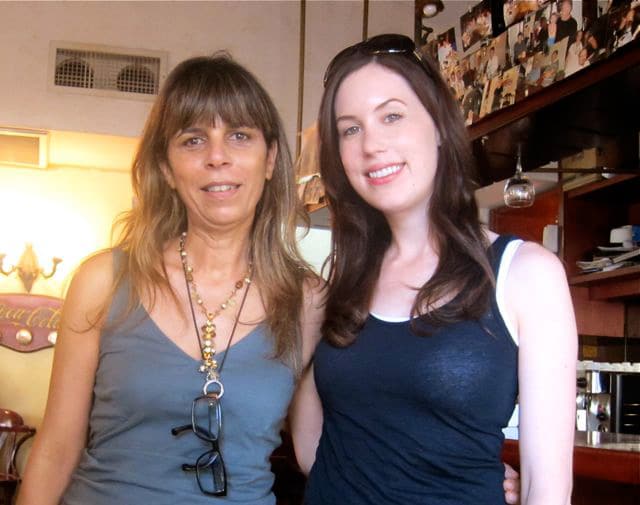
With Miri, the manager of Batia restaurant in Tel Aviv.
On a trip to Israel in the summer of 2010, our friend Hagai brought me to a restaurant called Batia in Tel Aviv. It’s a traditional Ashkenazi restaurant, well known for their cholent. While there I met the manager, Miri. She gave me a tour of their kitchen and I got to snap a shot of their massive cholent pot, which is the size of about twelve normal cholent pots. Check it out:
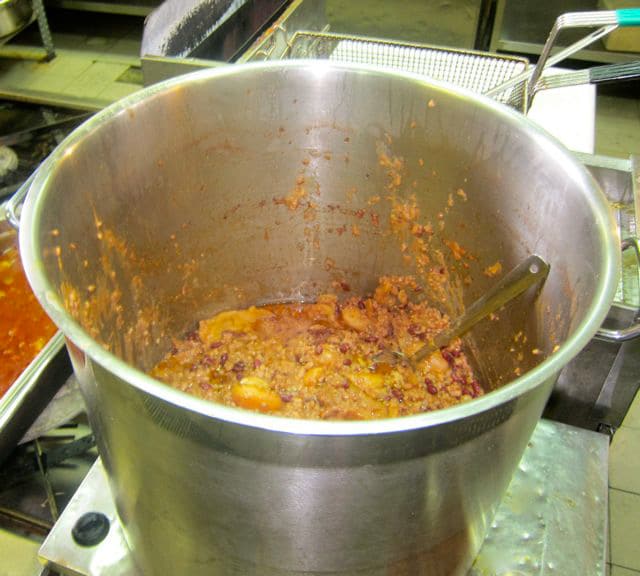
Huge cholent pot at Batia Restaurant – Tel Aviv, Israel.
Miri told me that even with all of this cholent, they never fail to run out towards the end of the day. It is absolutely delicious. Their cholent is made in the Israeli style with eggs, similar to mine but with less spices. They also add a kishke to their cholent and sliced meat if you ask for it.

Batia’s famous cholent, complete with kishke.
Cholent: A Family Affair
Tamar Genger from the website Joy of Kosher talked about the warm memories and feelings that a pot of cholent can conjure. “People have an emotional response to the word ‘cholent’ — it may be a memory of a meal at a grandparents house, kiddush after shul or that unmistakable smell that warms the entire home on a cold winter morning.” I totally relate to this emotional response, even though I didn’t grow up eating cholent. For the past decade, cholent has made a regular appearance on our Shabbat table. During the winter, it doesn’t feel like Shabbat unless a pot of cholent is slowly cooking in the oven, filling the house with its tantalizing, savory aroma. Cholent and challah are the official flavors of Shabbat in our home.
Cholent recipes vary greatly from region to region, and even from family to family. No two cholent recipes are exactly alike. It’s one of those dishes that evolves over generations, with spices and ingredients being added or changed to suit family tastes. Some cholent recipes have a hint of sweetness in them from the addition of honey or ketchup. Our family prefers a savory cholent, the recipe for which appears below. Ashkenazi cholent recipes sometimes include kishke, or stuffed derma, which is a particularly unique Jewish delicacy. We never include a kishke, but you could certainly buy a kishke and add it to the pot. Couldn’t hurt!
Our family’s cholent recipe is a reflection of the heritage of my fiance’s parents; his mother was Sephardic, his father Ashkenazi. The dish uses the basic ingredients of an Ashkenazi cholent– meat, beans, potatoes, and sometimes barley or kasha– with added Sephardic spices for flavor. We also add whole eggs to the pot, another Sephardic custom. The eggs slowly cook in the broth, soaking up the flavor of the cholent and turning a lovely brown color. I sometimes use chickpeas, as is the custom in Moroccan dafina. Other times, I use a combination of kidney, pinto, and lima beans, which are more often used in Ashkenazi cholent. It just depends on what we have in the pantry on Friday. I use red potatoes because they have a lower starch content, so they won’t dissolve during the long slow cooking process. When we want a lighter cholent, I leave out the barley grains and let the potatoes take starchy center stage. Cholent is flexible that way. The result of combining all of these different flavors is an irresistible savory cholent that is always a hit on Shabbat.
Over the years I’ve refined this cholent recipe. I used to overnight soak the beans, pre-boil the ingredients and often cooked it in the oven. Now I always use a slow cooker, and I only give the beans a quick soak. If I’m in a hurry I skip the soak entirely– the quick soaked beans are easier on digestion, but the slow cooking process will fully cook the raw beans. Remember, this dish cooks overnight, which requires some forethought. The traditional way is to start the cooking on Friday before sundown so that the pot is cooking before Shabbat begins. Enjoy!
Recommended Products:
We are a participant in the Amazon Services LLC Associates Program, an affiliate advertising program designed to provide a means for us to earn fees by linking to Amazon.com and affiliated sites. As an Amazon Associate I earn from qualifying purchases.
Food Photography Beauty Shots & Styling by Louise Mellor

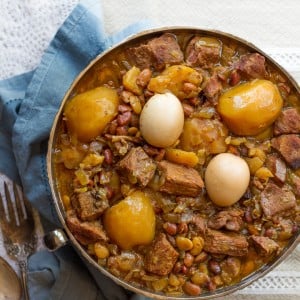
Cholent
Ingredients
- 2 1/2 pounds large red potatoes, peeled and halved (for a smaller slow cooker, use 2 lbs)
- 2 whole onions, chopped
- 2 1/2 pounds beef stew meat or brisket, cut into chunks (for a smaller slow cooker, use 2 lbs)
- 2 marrow bones
- 1 cup dried beans - lima, pinto, chickpeas, red beans (not kidney), or a mixture
- 1/2 cup pearl barley or coarse-grain kasha (optional - for gluten free, do not use pearl barley)
- 3 whole garlic cloves
- 6 eggs (optional)
- 1/2 teaspoon black pepper (if spice sensitive use 1/4 tsp)
- 1 quart low sodium chicken broth
- 1 tablespoon kosher salt
- 1 1/2 teaspoons paprika
- 1 1/2 teaspoons turmeric
- 1 teaspoon cumin
- 1/4 teaspoon cayenne (if spice sensitive use just a pinch)
- 1 kishke (optional - we never add this, but many families like it)
- Water (varies)
NOTES
Instructions
- In a large slow cooker (the larger the better!), place the potatoes in a single layer on the bottom of the cooking vessel.

- Sprinkle the onions over the potatoes.

- Place the beef in a single layer on top of the onions and potatoes. Place the two marrow bones in the meat. If you're adding a kishke, now would be the time to put it in the cooker.

- Rinse the beans clean, checking for any stones or impurities. If using barley or kasha, do the same with the grains. Sprinkle the beans (raw or pre-soaked) and optional grains over the top of the meat. Place the three whole garlic cloves into the meat, evenly spaced. Sprinkle the whole mixture with the black pepper.

- If using eggs, rinse them well and then tuck them into the meat. In a 4-cup container, whisk together the low sodium chicken broth, kosher salt, paprika, turmeric, cumin and cayenne.

- Pour the liquid over the cholent. Add additional water until all of the beans and pieces of meat are covered. For us, it's usually another 1-2 cups of water in our slow cooker-- it will vary; I usually add a bit more liquid if using grains, because they will soak it up.

- Cover the slow cooker. Cook on low heat for 16 hours. Check occasionally as it's cooking; add additional water and stir a bit if it's looking too dry. Most cookers will auto-switch to warm when the cooking is complete. If yours doesn’t, set it to warm until ready to serve.

- It will look a bit medieval when it's done cooking! Don't worry, just dig in and you'll see that it's perfectly cooked below the surface. Peel the eggs before serving the cholent.

- To cook this recipe in the oven, layer the ingredients in a large heavy 7-8 quart Dutch oven. Make sure you have enough liquid to just cover all ingredients. Cover with lid and cook cholent at 200 degrees F for 12-16 hours.

Nutrition

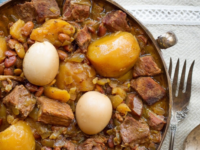


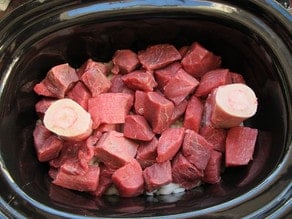
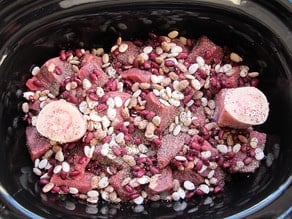
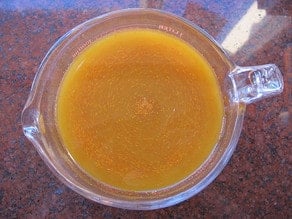
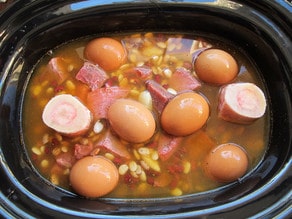

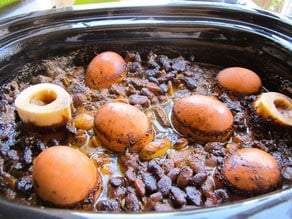
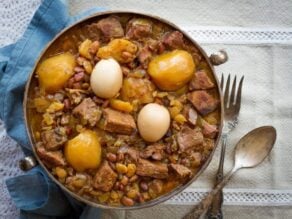


Wonderful Recipe! Thank you for sharing!
Hi. This is my go to recipe and I NEVER have any left overs. The only two changes I have made is I have replaced the beef with lamb and I have added portobello mushrooms to the choulent. Thank you very much for posting this.
Excellent David! Thanks for leaving your feedback.
I believe searing the meat prior to cooking in the slow cooker will remove a great deal of unhealthy animal fats.
Keep coming back to this one; always fantastic! My husband says almost like the one from his grandma, so that’s all I have to say 🙂 thanks for sharing
I always love comments like this… if it passes the grandma test, I feel very proud, indeed! Thanks for sharing, Kerstin.